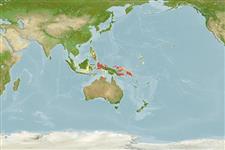>
Blenniiformes (Blennies) >
Blenniidae (Combtooth blennies) > Blenniinae
Etymology: Meiacanthus: Greek, meion = less = lessen + Greek, akantha = thorn (Ref. 45335); crinitus: Specific epithet means 'hairy', referring to the elongate inner caudal-fin rays which distinguish the adult males..
Environment: milieu / climate zone / depth range / distribution range
Ecologia
marinhas demersal; intervalo de profundidade 0 - 20 m (Ref. 90102). Tropical
Western Central Pacific: Indonesia.
Tamanho / Peso / Idade
Maturity: Lm ? range ? - ? cm
Max length : 10.0 cm TL macho/indeterminado; (Ref. 48636)
Descrição suscinta
Chaves de identificação | Morfologia | Morfometria
Males with long filament extending from one or two rays of the tail (Ref. 48636).
A shallow water species, forming small aggregations in well protected narrow bays or inlets. Usually in sponge habitats (Ref. 48636). Adults may be found solitary or in pairs (Ref. 90102). Oviparous. Eggs are demersal and adhesive (Ref. 205), and are attached to the substrate via a filamentous, adhesive pad or pedestal (Ref. 94114). Larvae are planktonic, often found in shallow, coastal waters (Ref. 94114). Mimics the young of Pentapodus trivittata (Ref. 90102). Minimum depth of 0 m reported from Ref.7401.
Ciclo de vida ou comportamento de acasalamento
Maturities | Reprodução | Spawnings | Egg(s) | Fecundities | Larvas
Oviparous, distinct pairing (Ref. 205).
Smith-Vaniz, W.F., 1987. The saber-toothed blennies, tribe Nemophini (Pisces: Bleniidae): an update. Proc. Acad. Nat. Sci. Philad. 139:1-52. (Ref. 7401)
Status na Lista Vermelha da UICN (Ref. 130435)
Ameaça para os humanos
Harmless
Uso pelos humanos
Ferramentas
Relatórios especiais
Baixar XML
Fontes da internet
Estimates based on models
Preferred temperature (Ref.
123201): 28.8 - 29.3, mean 29 °C (based on 262 cells).
Índice de diversidade filogenética (Ref.
82804): PD
50 = 0.5000 [Uniqueness, from 0.5 = low to 2.0 = high].
Bayesian length-weight: a=0.01122 (0.00514 - 0.02450), b=3.04 (2.87 - 3.21), in cm total length, based on all LWR estimates for this body shape (Ref.
93245).
Nível Trófico (Ref.
69278): 3.4 ±0.4 se; based on size and trophs of closest relatives
Resiliência (Ref.
120179): Elevada, tempo mínimo de duplicação da população menor que 15 meses (Preliminary K or Fecundity.).
Fishing Vulnerability (Ref.
59153): Low vulnerability (10 of 100).
Nutrients (Ref.
124155): Calcium = 350 [212, 841] mg/100g; Iron = 1.86 [1.13, 3.25] mg/100g; Protein = 17.7 [16.7, 18.6] %; Omega3 = 0.23 [0.13, 0.42] g/100g; Selenium = 32.8 [16.2, 73.0] μg/100g; VitaminA = 53.7 [16.9, 170.2] μg/100g; Zinc = 2.07 [1.37, 3.05] mg/100g (wet weight);
